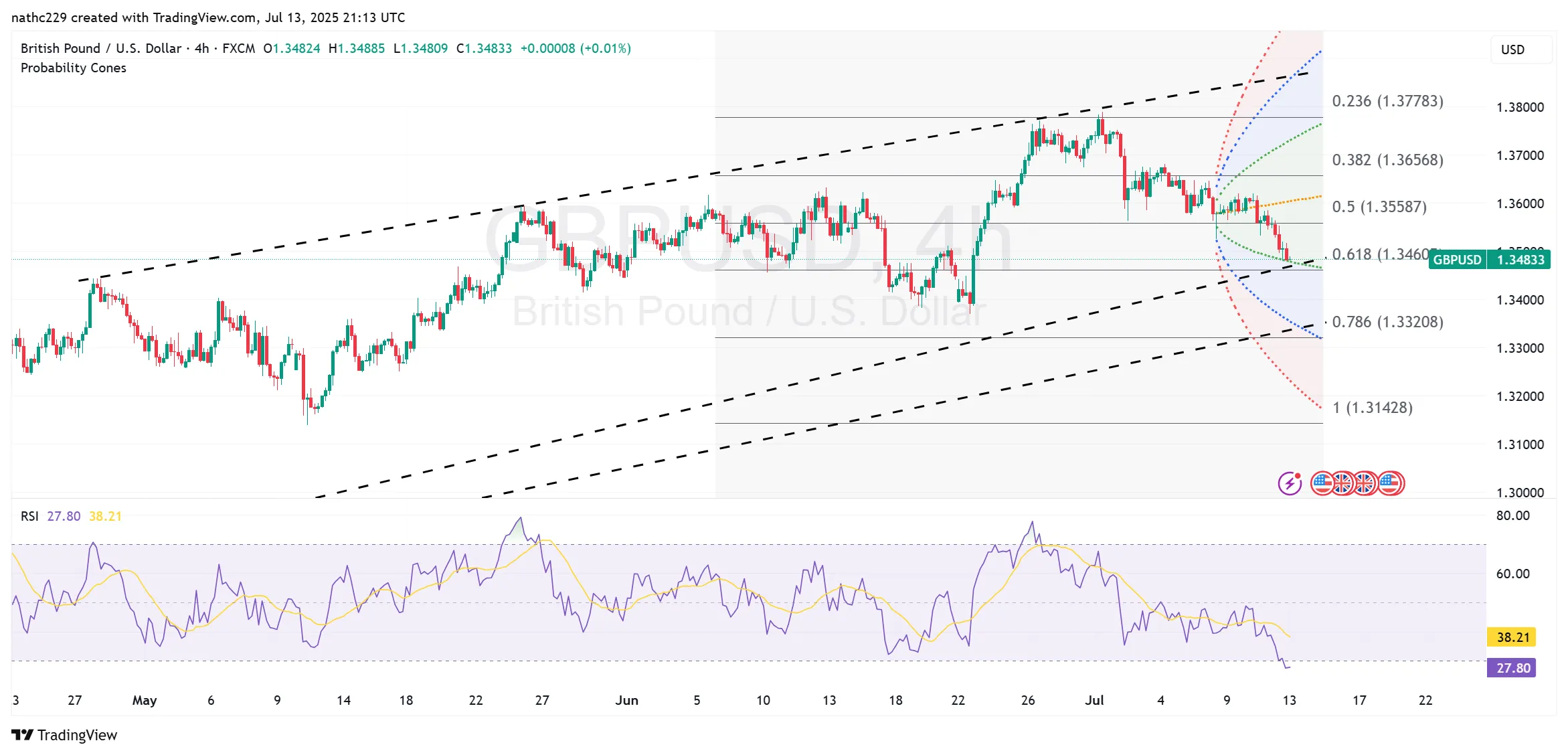
GBP/USD Bearish Pressure Intensifies Amid Weak UK Data and Rising Tariff Concerns
GBP/USD Bearish Pressure Intensifies Amid Weak UK Data and Rising Tariff Concerns
Overview
GBP/USD has recently come under significant bearish pressure, weighed down by disappointing UK economic data and escalating tariff concerns. The combination of softer-than-expected GDP and industrial output figures, alongside renewed anxiety over potential tariff-induced inflation, has accelerated bearish sentiment. As sterling drifts near key support levels, traders are closely monitoring upcoming data releases and central bank signals for further directional clues.
Technical Analysis
GBP/USD has experienced a marked downward trajectory, recently sliding to test two-week lows around 1.3481. This decline comes after a failure to sustain gains above the critical 10-day moving average, currently situated at 1.3629. The bearish breach below this moving average significantly undermines the short-term bullish outlook, indicating increasing bearish control.
Immediate support levels now crucially come into play around the rising 55-day moving average at 1.3482. Friday’s session low at 1.3481 further reinforces this technical support area. A break and sustained close below this support cluster would open the path to deeper declines towards the daily Ichimoku cloud top at 1.3447, with additional support at the rising lower boundary of the 30-day Bollinger Band near 1.3409.
On the upside, resistance is clearly defined by Friday’s session high of 1.3583. However, the key technical barrier remains the falling 10-day moving average at 1.3629, which previously provided support and now acts as significant resistance. Further upside resistance is marked by the upper boundary of the 30-day Bollinger Band at 1.3748, which has served as a robust cap for recent bullish attempts.
Momentum indicators such as the Relative Strength Index (RSI) continue to trend downward, further signaling bearish momentum. The technical landscape overall strongly supports a continued bearish outlook unless significant positive economic or geopolitical catalysts emerge.
Economic Indicators and Market Drivers
Recent economic data from the UK have significantly contributed to sterling’s bearish sentiment. The latest GDP and industrial output figures missed market expectations, highlighting growing vulnerabilities in the UK economy. This disappointing data has rekindled market fears regarding potential rate cuts by the Bank of England, placing additional downward pressure on GBP/USD.
Upcoming economic indicators will be crucial for determining short-term market sentiment. UK retail sales figures scheduled for Monday, followed by U.S. CPI data on Tuesday and UK CPI data on Wednesday, are particularly critical. These releases will provide insights into inflation trends and consumer spending, directly impacting expectations around future rate decisions by the Bank of England and the Federal Reserve.
The latest Interest Rate Probability Rates (IRPR) from LSEG indicate a parallel monetary policy path between the Fed and the Bank of England for the remainder of 2025, with the Fed anticipated to adopt a more dovish stance heading into the second half of 2026. Despite this dovish Fed outlook, the resurgence of tariff concerns driven by recent geopolitical developments is reinvigorating global inflation fears, thereby enhancing short-term dollar appeal.
Risks and Consequences
The primary risk to GBP/USD remains continued weakness in UK economic data, which could further solidify expectations of imminent rate cuts by the Bank of England. Persistent underperformance in key economic metrics, particularly in consumer spending and inflation, would significantly bolster the bearish scenario.
Additionally, heightened geopolitical and tariff-related uncertainties present ongoing volatility risks. Escalating global trade tensions could further exacerbate inflationary pressures, potentially prompting shifts in market sentiment favoring the U.S. dollar and further undermining sterling.
From a technical standpoint, a confirmed breach below critical support levels around 1.3481 and the 55-day moving average would open substantial downside potential, potentially targeting psychological and technical support at 1.3250, marking a substantial retracement of the recent bullish trend.
Trading Recommendations
Bearish traders currently have significant momentum and should monitor for confirmation of a sustained break below key support levels around 1.3481 and 1.3447 to enhance bearish positions. Protective stop-loss orders should be strategically positioned slightly above immediate resistance levels at 1.3583 and the critical 10-day moving average at 1.3629.
Bullish traders, conversely, should remain cautious, awaiting clear technical signals of a reversal or stabilization above the declining 10-day moving average (1.3629) before initiating new long positions. Strong economic data from upcoming releases would be necessary to support renewed bullish sentiment.
Conclusion
GBP/USD faces intense bearish pressures driven by weak UK economic indicators and renewed tariff fears. Critical technical support and resistance levels are under scrutiny as traders carefully monitor forthcoming economic data releases for clarity on potential market direction.
